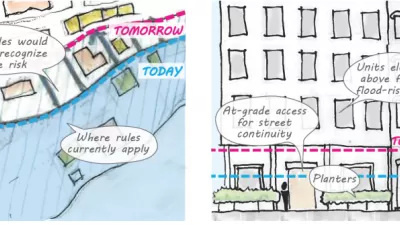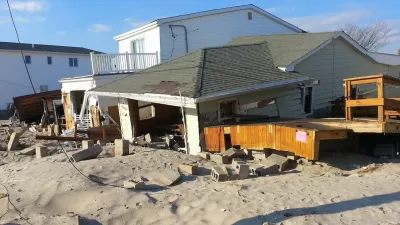Only a few places have managed to stem the tide of development in areas at risk to the effects (like wildfire and flooding) of climate change. Virginia Beach is an early test bed for what it takes to tell developers "no."

Christopher Flavelle and John Schwartz report from Virginia Beach, where the city recently became a leader in climate-aware development restrictions—i.e., saying no to developers proposing buildings on land at risk of flooding from sea-level rise and extreme weather.
The city last year became one of a small but growing number of communities willing to say no to developers — despite their political and economic clout — when it rejected a proposal to build a few dozen homes on this soggy parcel of 50 acres, arguing that those homes would be unsafe. The developers sued, accusing officials of making their project a scapegoat as voters clamored for action after disastrous flooding.
This past May, a judge ruled that Virginia Beach was within its rights to stop the development. The city’s experience could become a harbinger for others nationwide.
According to the article, the confrontation between Virginia Beach and this developer is emblematic of many future, similar conflicts, the outcomes of which will determine the vulnerability of Americans to climate change in the future. The recent track record of this conflict has favored developers and introduced risk to many communities:
In many coastal states, homes are going up at the fastest rate in the most flood-prone areas. The number of new houses in what experts call the wildland-urban interface, where the wildfire threat tends to be greatest, increased 41 percent nationwide between 1990 and 2010.
A recent report from the Pew Charitable Trusts provides additional background for the this feature-length story. The "Mitigation Matters: Policy Solutions to Reduce Local Flood Risk" report is available online.
FULL STORY: As Climate Risk Grows, Cities Test a Tough Strategy: Saying ‘No’ to Developers

Montreal Mall to Become 6,000 Housing Units
Place Versailles will be transformed into a mixed-use complex over the next 25 years.

Planetizen Federal Action Tracker
A weekly monitor of how Trump’s orders and actions are impacting planners and planning in America.

California High-Speed Rail's Plan to Right Itself
The railroad's new CEO thinks he can get the project back on track. The stars will need to align this summer.

Tenant Advocates: Rent Gouging Rampant After LA Wildfires
The Rent Brigade says it's found evidence of thousands of likely instances of rent gouging. In some cases, the landlords accused of exploiting the fires had made campaign donations to those responsible for enforcement.

Seattle’s Upzoning Plan is Ambitious, Light on Details
The city passed a ‘bare-bones’ framework to comply with state housing laws that paves the way for more middle housing, but the debate over how and where to build is just getting started.

DOJ Seeks to End USDOT Affirmative Action Program
The Disadvantaged Business Enterprise Program encouraged contracting with minority- and women-owned businesses in the transportation sector, where these groups are vastly underrepresented.
Urban Design for Planners 1: Software Tools
This six-course series explores essential urban design concepts using open source software and equips planners with the tools they need to participate fully in the urban design process.
Planning for Universal Design
Learn the tools for implementing Universal Design in planning regulations.
City of Camden Redevelopment Agency
City of Astoria
Transportation Research & Education Center (TREC) at Portland State University
City of Camden Redevelopment Agency
Municipality of Princeton (NJ)
Regional Transportation Commission of Southern Nevada





























